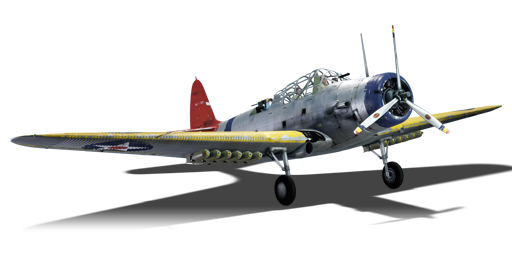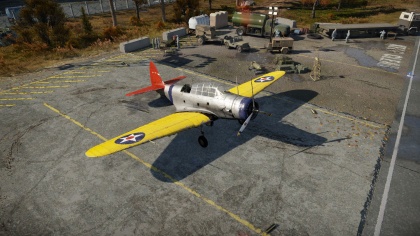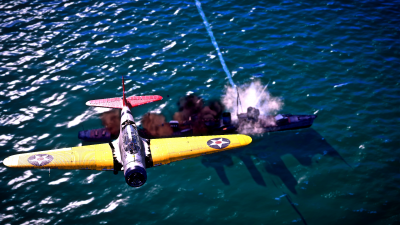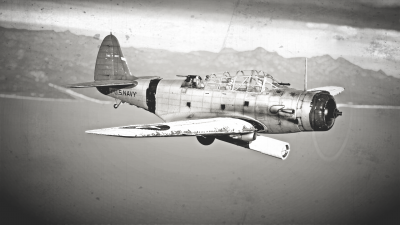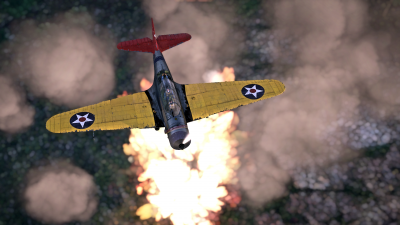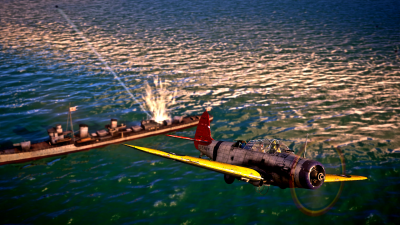TBD-1
Contents
Description
The TBD-1 Devastator is a rank I American torpedo bomber
with a battle rating of 1.0 (AB/RB) and 1.7 (SB). It was introduced in Update 1.53 "Firestorm".
The TBD-1 is the first usable bomber in the U.S. aircraft line up. While the likes of the OS2Us and the SB2Us are capable of bombing, they cannot do what the TBD-1 can do and that is to carry a torpedo or optionally upwards of 1,600 lbs (725 kg) of bombs. The Devastator is adept at bombing either naval or land-based targets. On maps with naval ships, torpedoes require the little naval bomber to release from a very low altitude, a maximum of 340 ft ( 104 m) or 820 ft (250 m) depending on the torpedo used. For those pilots who prefer utilizing bombs, they can be just as easily used on ships as on land-based vehicles except to ensure greater accuracy; this requires the aircraft to be quite low to the ground.
The lone offensive machine gun does not offer much, but can be effectively used to pick off damaged ground targets or even getting a luck shot on an enemy fighter. The lone rear-facing dorsal machine gun is not a miracle worker, though it does a good job of making it difficult for enemy fighters to sit on the TBD-1’s tail. The aircraft is quite manoeuvrable and can quickly whip around to attempt a second bombing run on a target if there are any bombs left over. Though state-of-the-art when developed, this bomber was quickly outdated, but that did not stop it being utilised at the beginning of World War II. While in War Thunder this bomber might seem to be an easy target for new pilots, those with some practice under their belt can utilise this as a very effective early bomber, racking up destroyed ground vehicles and anti-aircraft artillery targets.
General info
Flight Performance
Describe how the aircraft behaves in the air. Speed, manoeuvrability, acceleration and allowable loads - these are the most important characteristics of the vehicle.
| Characteristics | |||||||
|---|---|---|---|---|---|---|---|
| Stock | |||||||
| Max Speed (km/h at 2,500 m) |
Max altitude (meters) |
Turn time (seconds) |
Rate of climb (meters/second) |
Take-off run (meters) | |||
| AB | RB | AB | RB | AB | RB | ||
| 298 | 287 | 6000 | 19.8 | 20.5 | 4.3 | 4.3 | 150 |
| Upgraded | |||||||
| Max Speed (km/h at 2,500 m) |
Max altitude (meters) |
Turn time (seconds) |
Rate of climb (meters/second) |
Take-off run (meters) | |||
| AB | RB | AB | RB | AB | RB | ||
| 327 | 312 | 6000 | 18.3 | 19.0 | 8.3 | 6.1 | 150 |
Details
| Features | ||||
|---|---|---|---|---|
| Combat flaps | Take-off flaps | Landing flaps | Air brakes | Arrestor gear |
| ✓ | ✓ | ✓ | X | ✓ |
| Limits | ||||
|---|---|---|---|---|
| Wing-break speed (km/h) |
Gear limit (km/h) |
Combat flaps (km/h) |
Max Static G | |
| + | - | |||
| 212 | ~8 | ~2 | ||
| Optimal velocities | |||
|---|---|---|---|
| Ailerons (km/h) |
Rudder (km/h) |
Elevators (km/h) |
Radiator (km/h) |
| < 465 | < 400 | < 380 | > 323 |
| Compressor (RB/SB) | ||
|---|---|---|
| Setting 1 | ||
| Optimal altitude | 100% Engine power | WEP Engine power |
| 2,620 m | 900 hp | 963 hp |
Survivability and armour
- 12.7 mm steel - behind the engine
- 12.7 mm steel - behind the pilot
Armaments
Offensive armament
The TBD-1 is armed with:
- 1 x 12.7 mm Browning M2 machine gun, nose-mounted (500 rpg)
Suspended armament
The TBD-1 can be outfitted with the following ordnance:
- 12 x 100 lb AN-M30A1 bombs (1,200 lb total)
- 1 х Mk.13 torpedo
- 1 х Mk.13/44 torpedo
- 2 x 500 lb AN-M64A1 bombs + 6 x 100 lb AN-M30A1 bombs (1,600 lb total)
Defensive armament
The TBD-1 is defended by:
- 1 x 7.62 mm Browning machine gun, dorsal turret (600 rpg)
Usage in battles
The first thing a pilot will notice about the TBD in gameplay is its "rubber-banding" tendency to return to a stable speed of about 250 km/h. The aircraft has mediocre energy retention, especially in a turn or when coming out of a dive. However, it is a stable and easy plane to fly, even in Realistic Battles. Strangely enough, the TBD has awesome acceleration from a standing start. The acceleration peters off after about 140 km/h (just above its stall speed) but makes it a nice plane to take-off, especially from carriers. The armament on this plane is very bad and will get shot down if engaged with a fighter. The TBD is a very attractive target for fighters so climb to an altitude of 5000 meters. When dropping bombs, decrease your throttle to 50% as the bombs are more accurate when flying slow.
This aircraft is best used in a ground strike role, carpet bombing ground targets with a large quantity of smaller bombs available out of the box, and in this role, it performs respectably. It features a single 12.7 mm MG attached to the starboard side of the engine, with a generous ammo load, but although the TBD has a good turning radius it is not recommended to engage as a fighter. A rear gunner also wields a 7.7 mm MG, and although its horizontal coverage is laughable, it is a welcome addition to a low-flying pilot with the ability to keep his enemies in his gunner's (or main gun's) sights.
It is important to note that the TBD suffers from extremely fragile flaps and gear, at least in Realistic and Simulator Battles; even combat flaps will break off at any speed above about 210 km/h, while the gear rip at about 180.
Manual Engine Control
| MEC elements | ||||||
|---|---|---|---|---|---|---|
| Mixer | Pitch | Radiator | Supercharger | Turbocharger | ||
| Oil | Water | Type | ||||
| Controllable | Controllable Not auto controlled |
Not controllable Not auto controlled |
Controllable Auto control available |
Separate | Not controllable 1 gear |
Not controllable |
Modules
| Tier | Flight performance | Survivability | Weaponry | ||
|---|---|---|---|---|---|
| I | Fuselage repair | Radiator | Turret 7 mm | ITC mk.III | |
| II | Compressor | Airframe | New 7 mm MGs (turret) | Improved torpedo | |
| III | Wings repair | Engine | Offensive 12 mm | SBC mk.I | |
| IV | Engine injection | Cover | New 12 mm MGs | ||
Pros and cons
Pros:
- Low stall speed
- Has a bombsight
- Has an arrestor hook for carrier landing
- Very stable and easy to fly
- Very manoeuvrable for a bomber
- Very good turn and roll rate
- Carries a decent quantity of bombs without requiring any research
- Great standing acceleration
- Cockpit offers somehow decent visibility
Cons:
- Armaments are extremely underwhelming, with a single 12.7 mm in front and a 7.62 mm in the rear
- Low sustainable "cruise" speed (200-250 km/h)
- Slow
- Very bad energy retention
- Bombs are mounted on external pylons
- A dive bomber without any air brakes
- Poor overall armament with limited defensive coverage
- No gun sight in cockpit other than a scope with an extremely limited (and very shaky) field of view
- Doesn't come with its Navy Blue camouflage unlike other US Navy planes
- Fragile flaps and gear
- Gunner has no armour
History
Describe the history of the creation and combat usage of the aircraft in more detail than in the introduction. If the historical reference turns out to be too long, take it to a separate article, taking a link to the article about the vehicle and adding a block "/ History" (example: https://wiki.warthunder.com/(Vehicle-name)/History) and add a link to it here using the main template. Be sure to reference text and sources by using <ref></ref>, as well as adding them at the end of the article with <references />. This section may also include the vehicle's dev blog entry (if applicable) and the in-game encyclopedia description (under === Encyclopedia Info ===, also if applicable).
Media
Excellent additions to the article would be video guides, screenshots from the game, and photos.
See also
Links to the articles on the War Thunder Wiki that you think will be useful for the reader, for example:
- reference to the series of the aircraft;
- links to approximate analogues of other nations and research trees.
External links
Paste links to sources and external resources, such as:
- topic on the official game forum;
- encyclopedia page on the aircraft;
- other literature.
| Douglas Aircraft Company | |
|---|---|
| Strike Aircraft | A-20G-25 · A-26B-10 · A-26B-50 · AD-2 · AD-4 · A-1H |
| Bombers | TBD-1 · B-18A · SBD-3 · BTD-1 · A-26C-45 · A-26C-45DT |
| Turboprops | A2D-1 |
| Jet Aircraft | F3D-1 · F4D-1 |
| A-4 Skyhawk | A-4B · A-4E Early |
| Export | ▄Havoc Mk I · ▄Boston Mk I · ▄DB-7 · ▂A-20G-30 · ▄AD-4 · ▄AD-4NA |
| A-4 Skyhawk | A-4H · A-4E Early (M) · Ayit · A-4E |
| The Douglas Aircraft Company merged with McDonnell Aircraft Corporation in 1967 to form McDonnell Douglas. | |
| USA bombers | |
|---|---|
| Dive | SB2U-2 · SB2U-3 · SBD-3 · SB2C-1C · SB2C-4 |
| Torpedo | TBD-1 · PBY-5 Catalina · PBY-5A Catalina · TBF-1C · BTD-1 |
| Medium | B-10B · B-18A · B-34 · PV-2D · B-25J-1 · B-25J-20 · A-26C-45 · A-26C-45DT · B-26B |
| Heavy | B-17E · B-17E/L · B-17G-60-VE · PB4Y-2 · B-24D-25-CO · B-29A-BN |
| Hydroplanes | OS2U-1 · OS2U-3 · PBM-1 "Mariner" · PBM-3 "Mariner" · PBM-5A "Mariner" |


